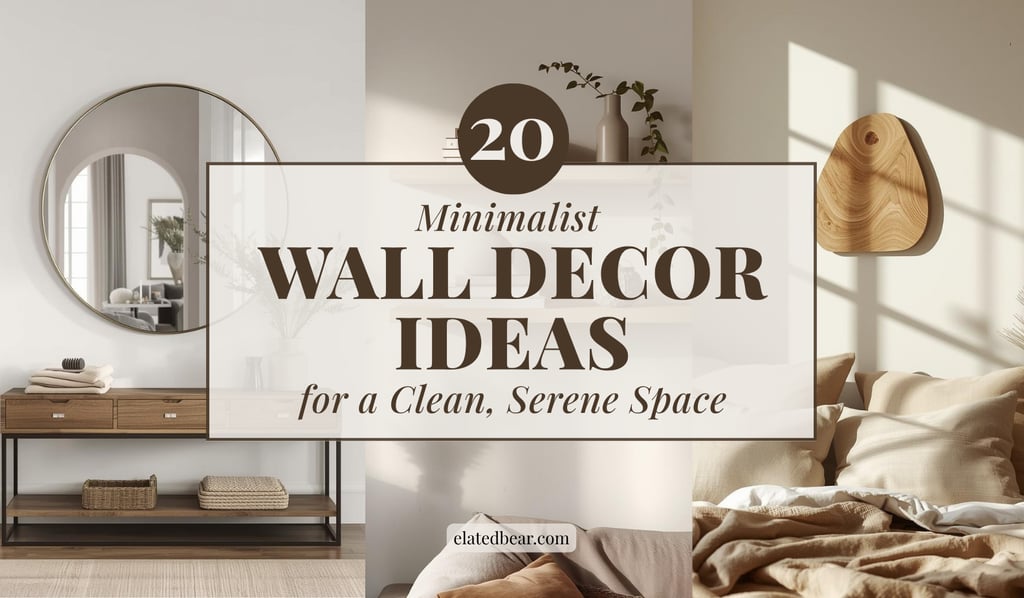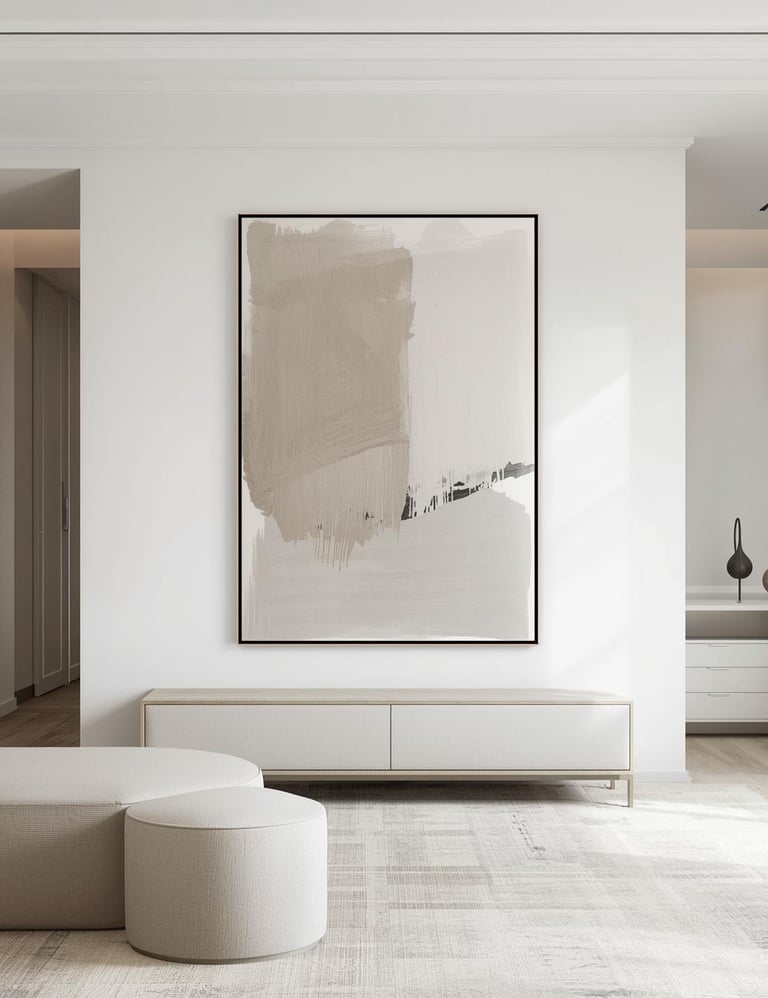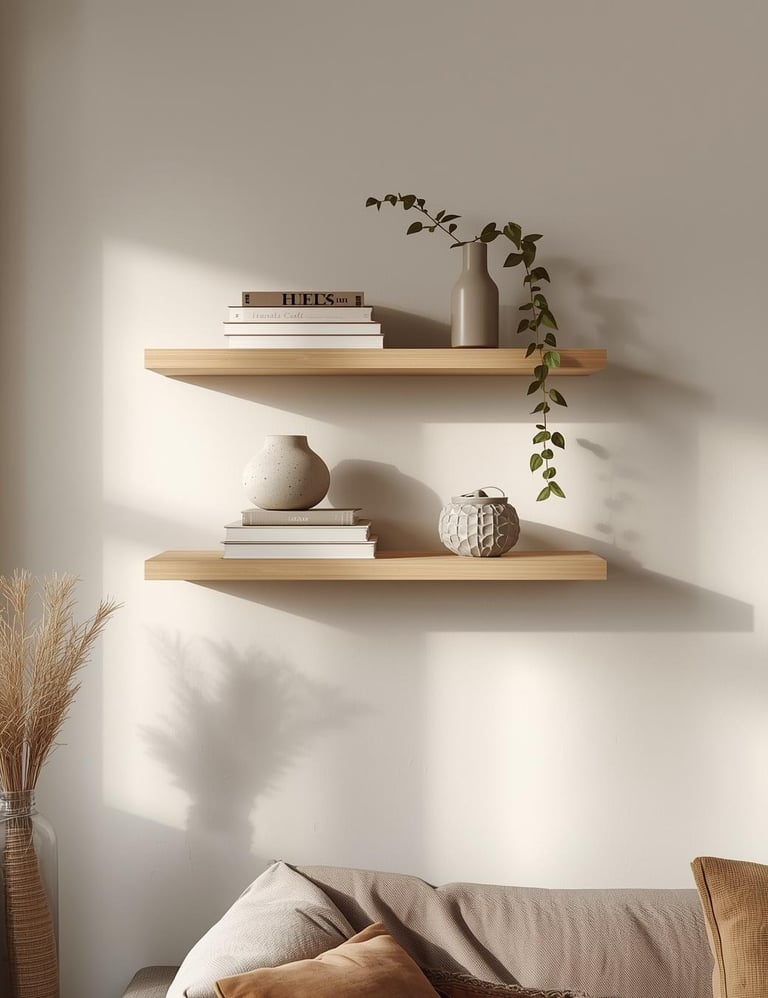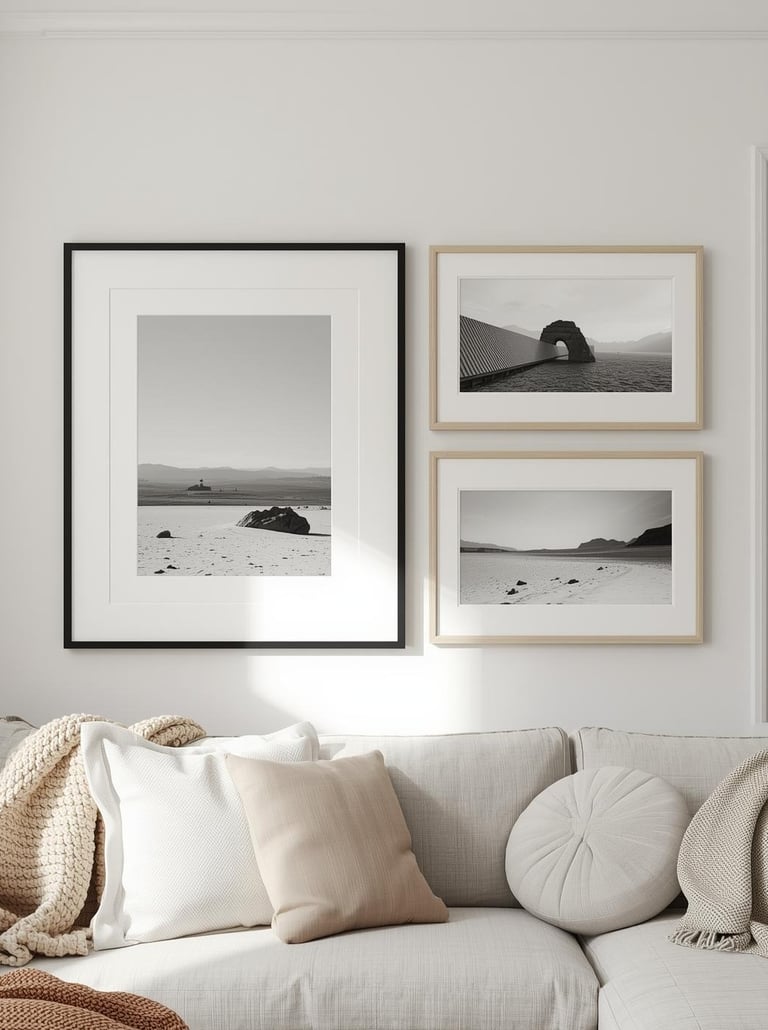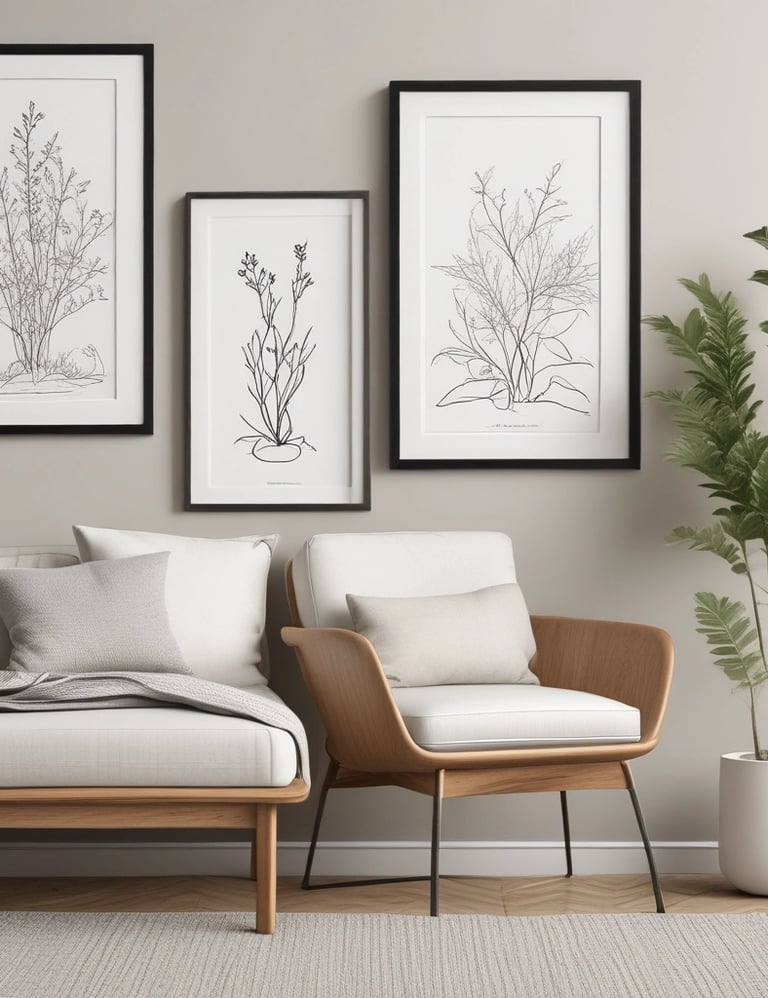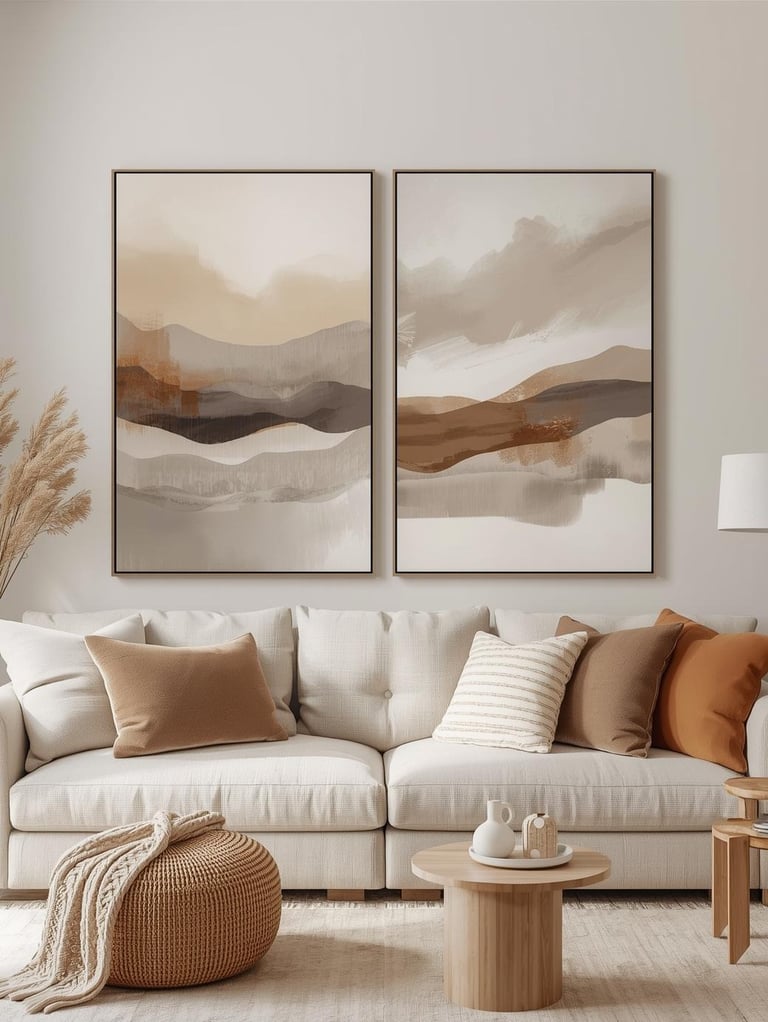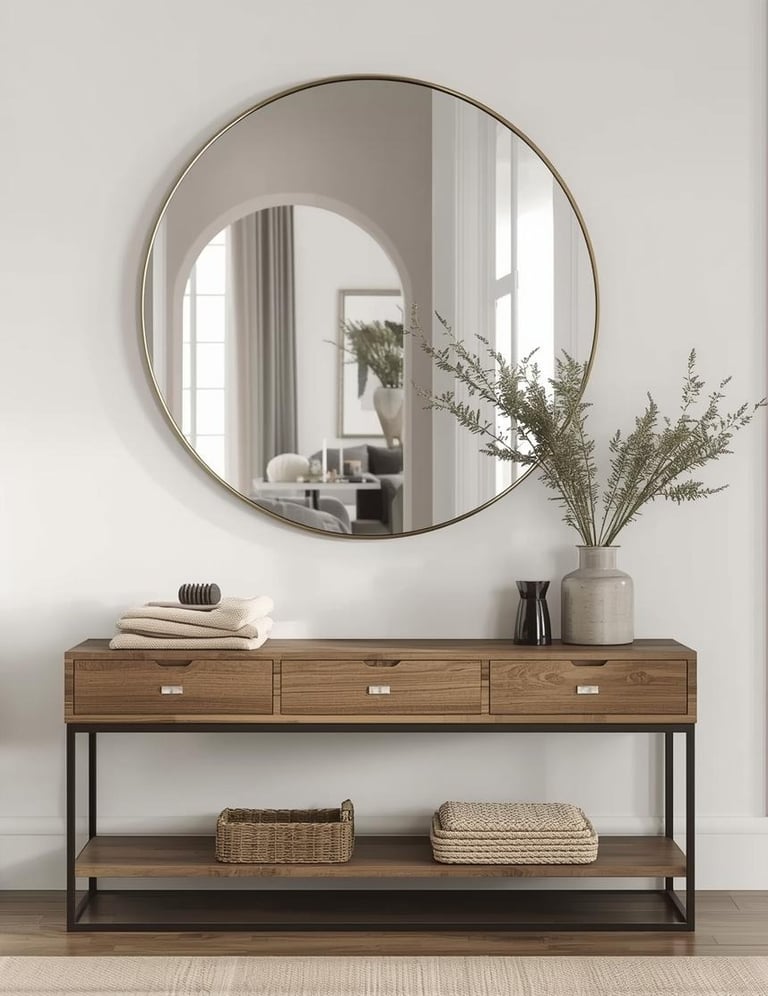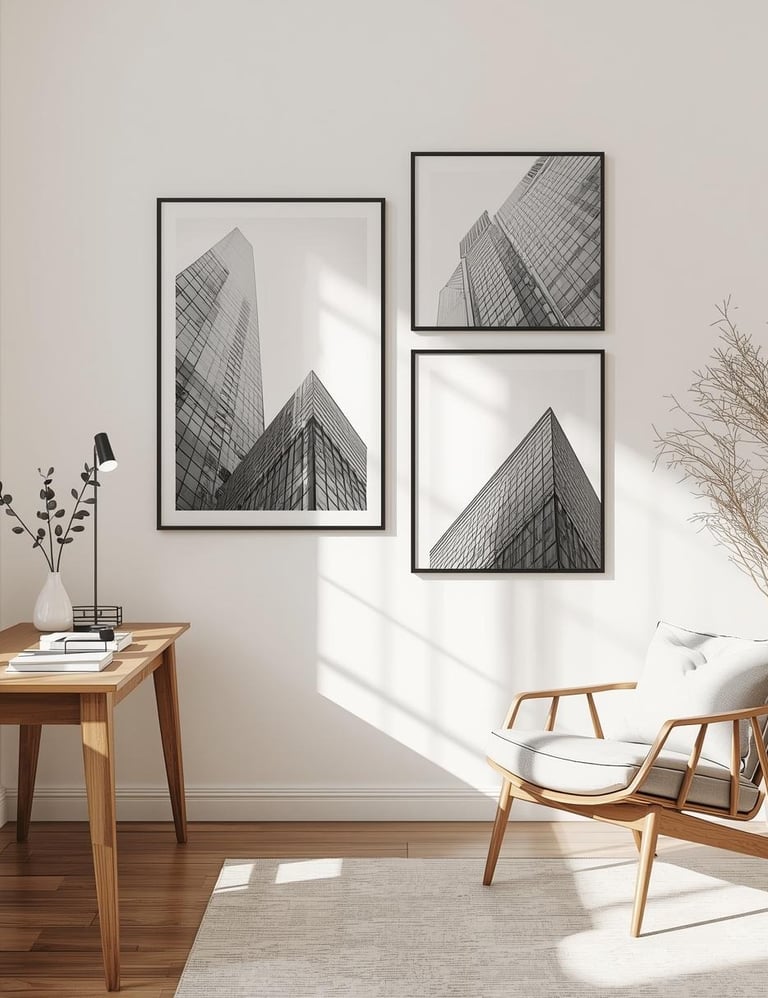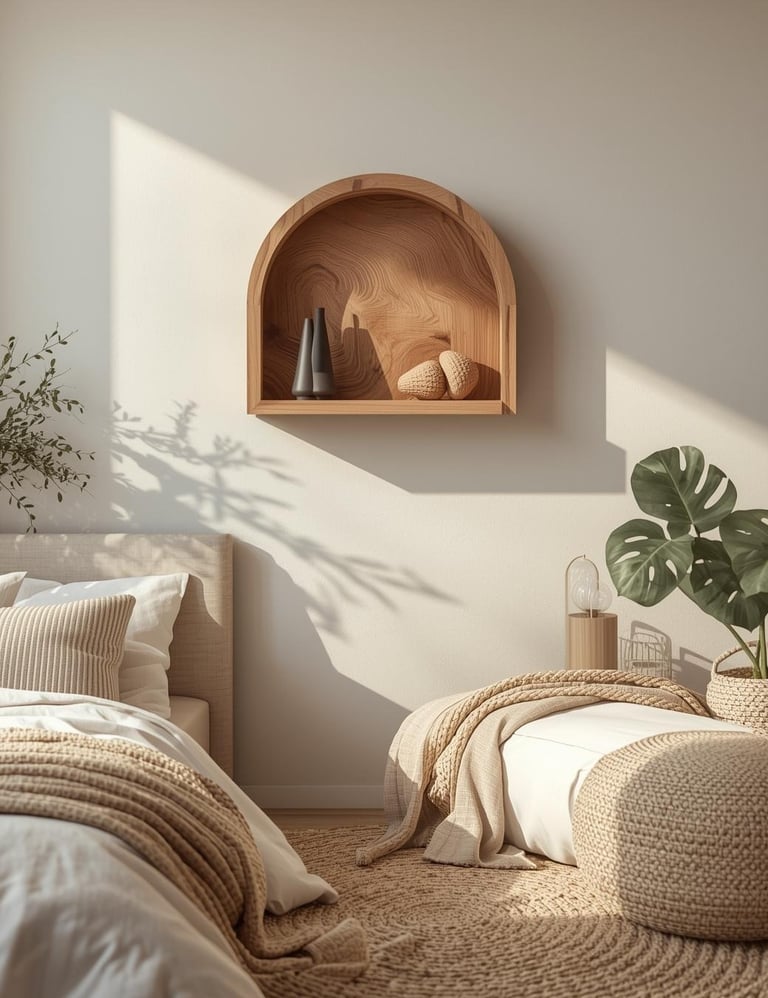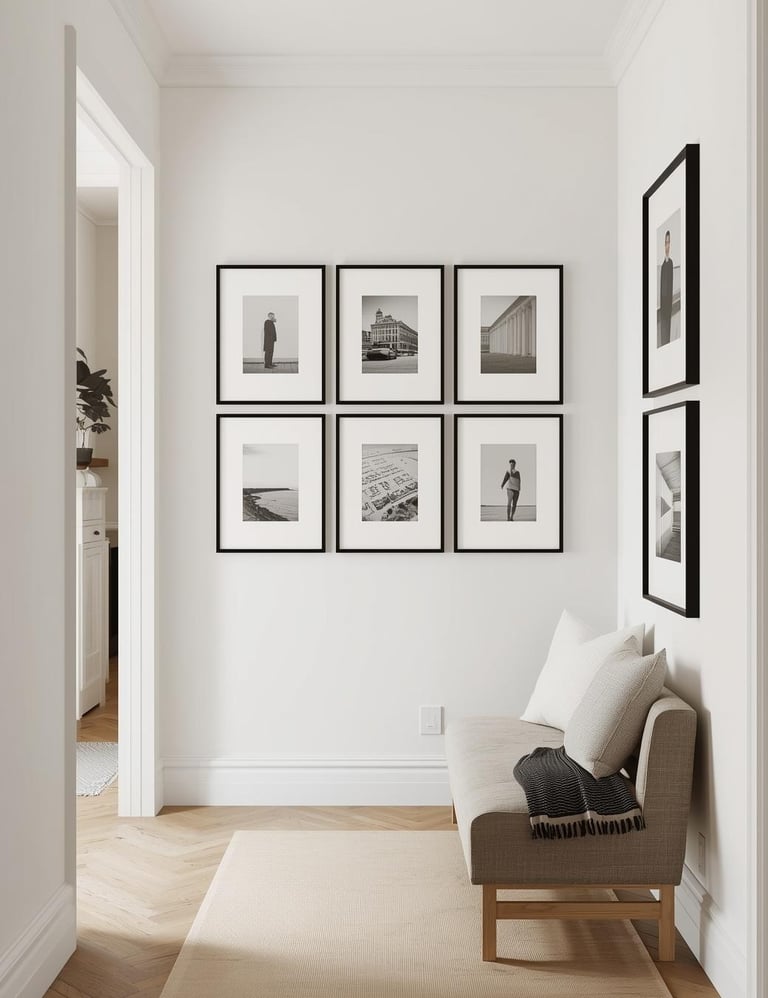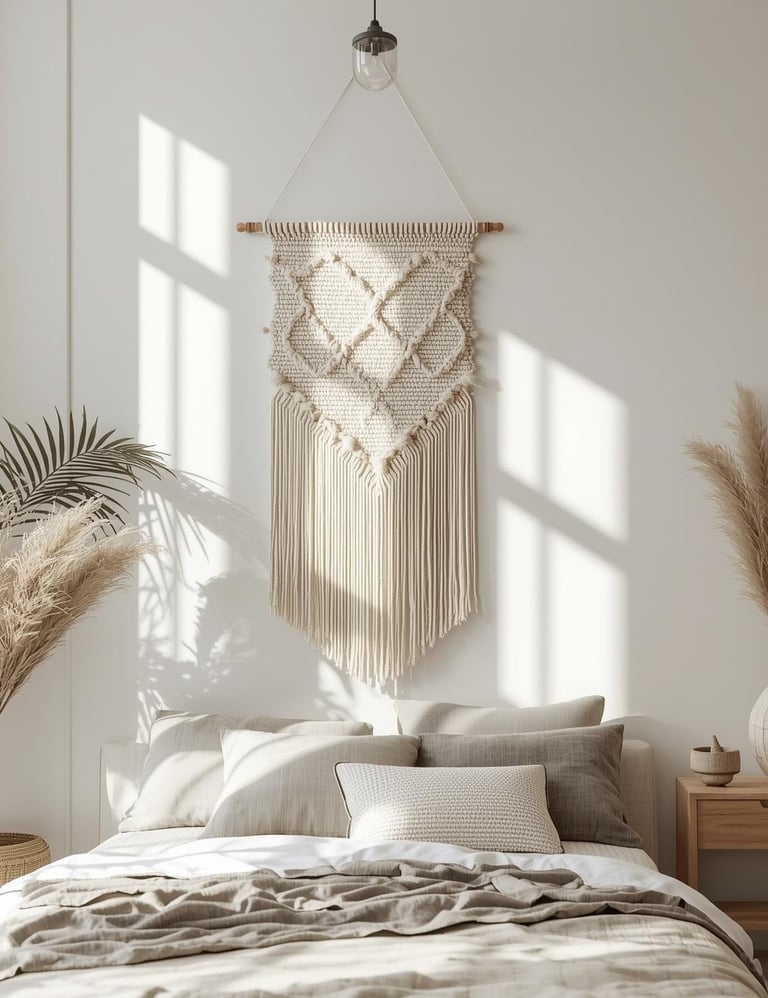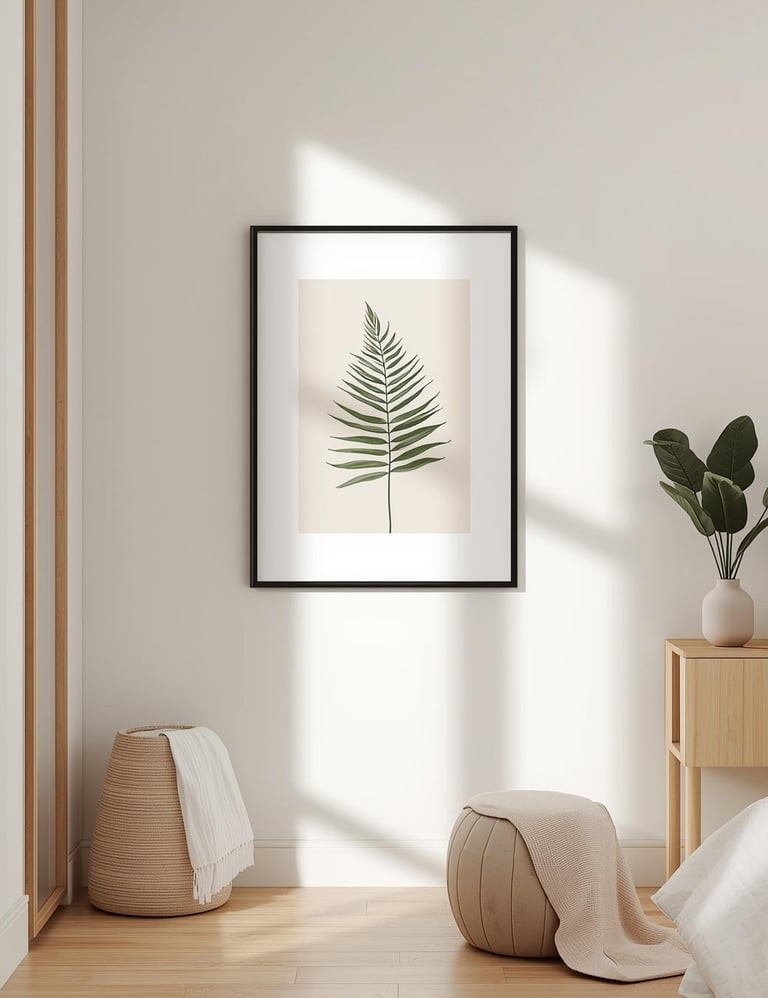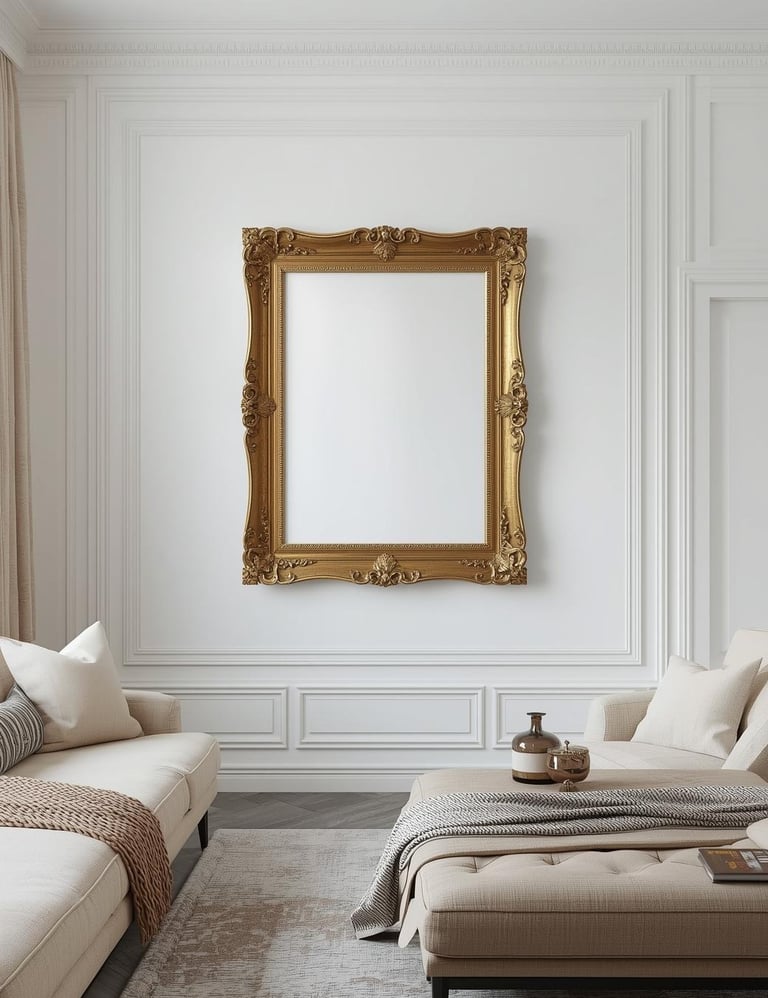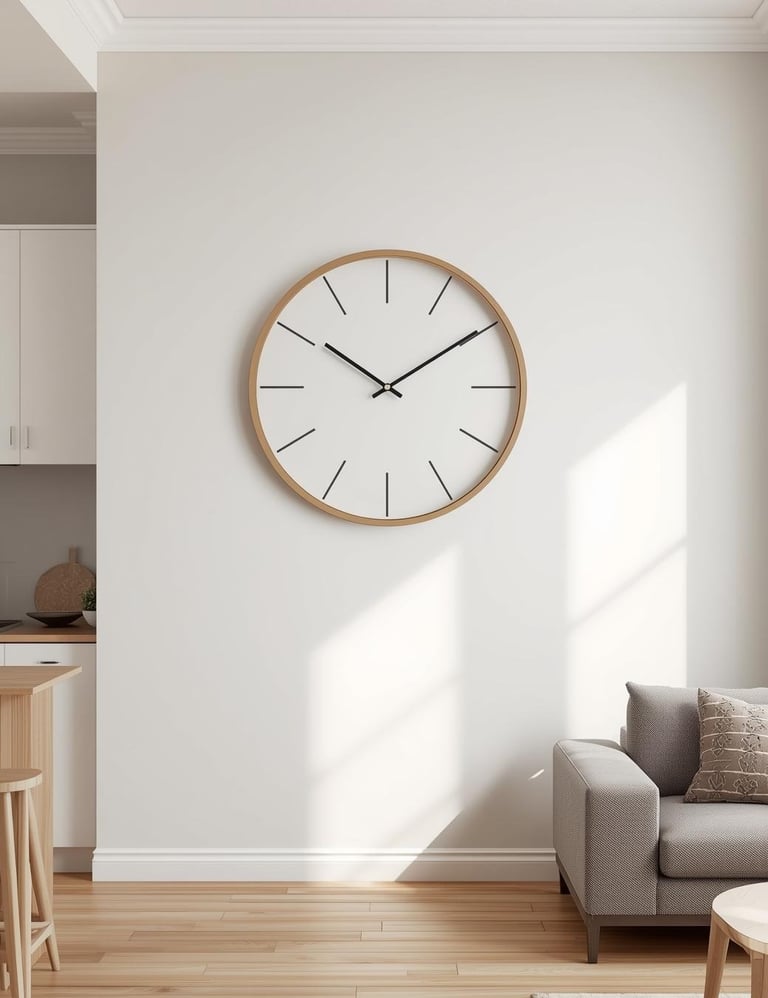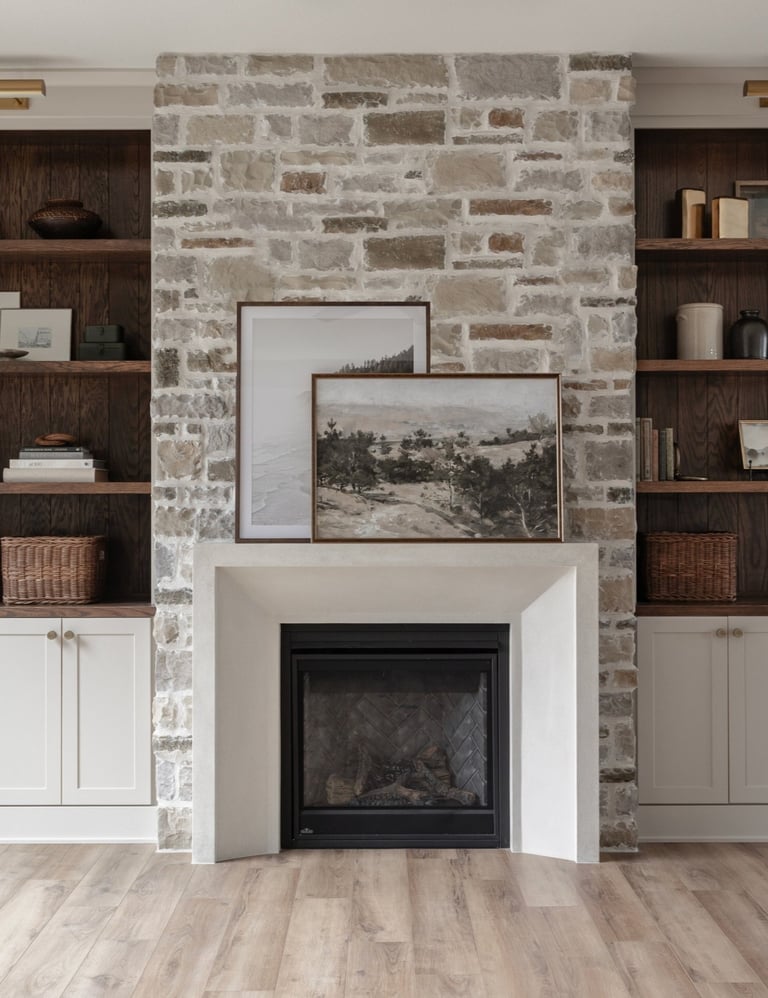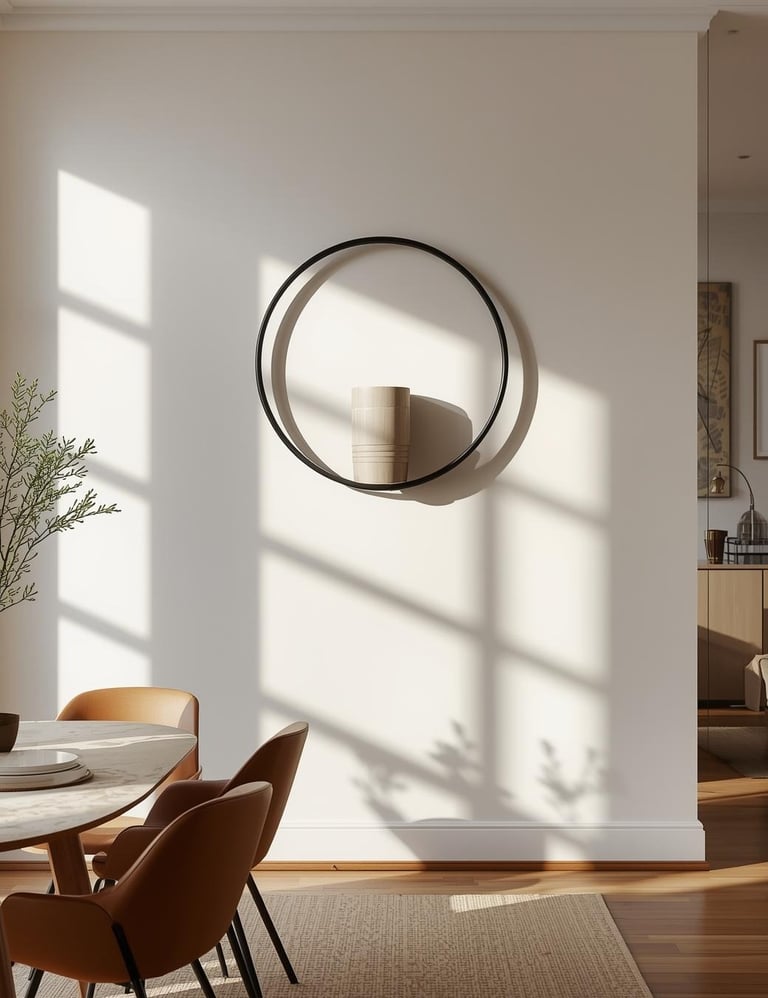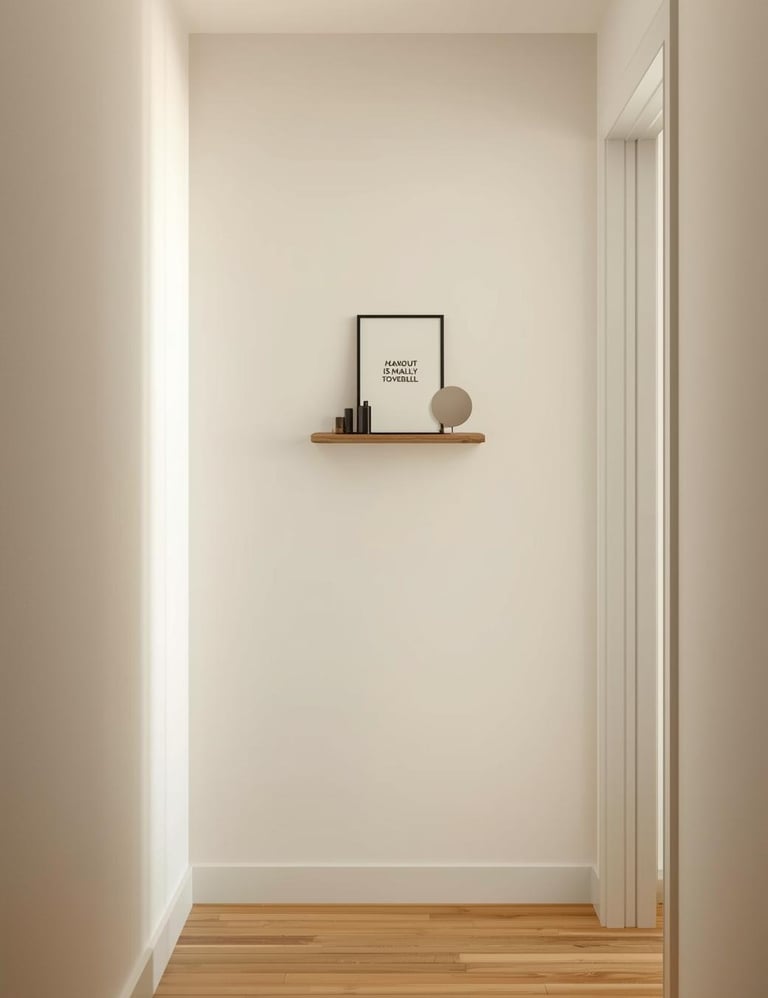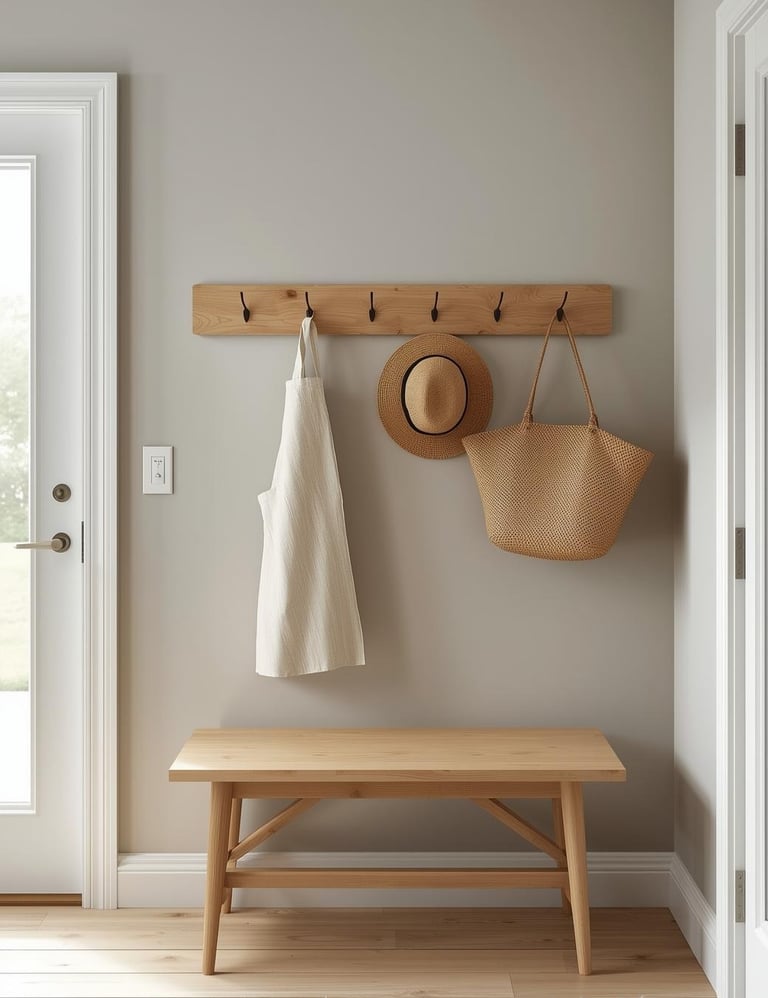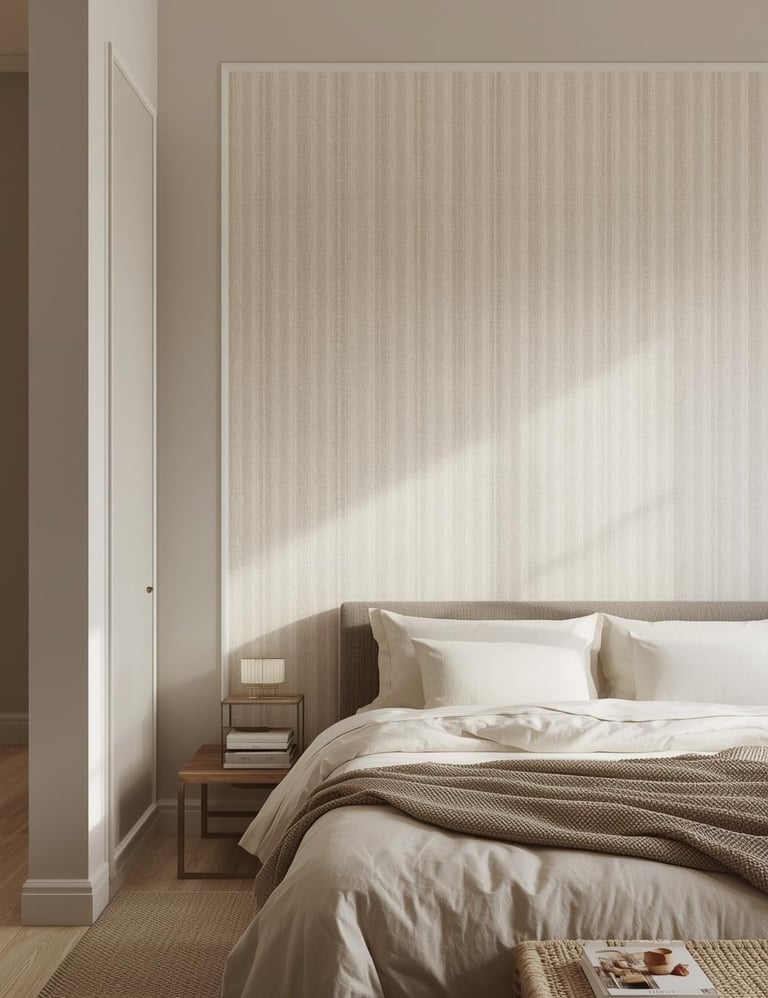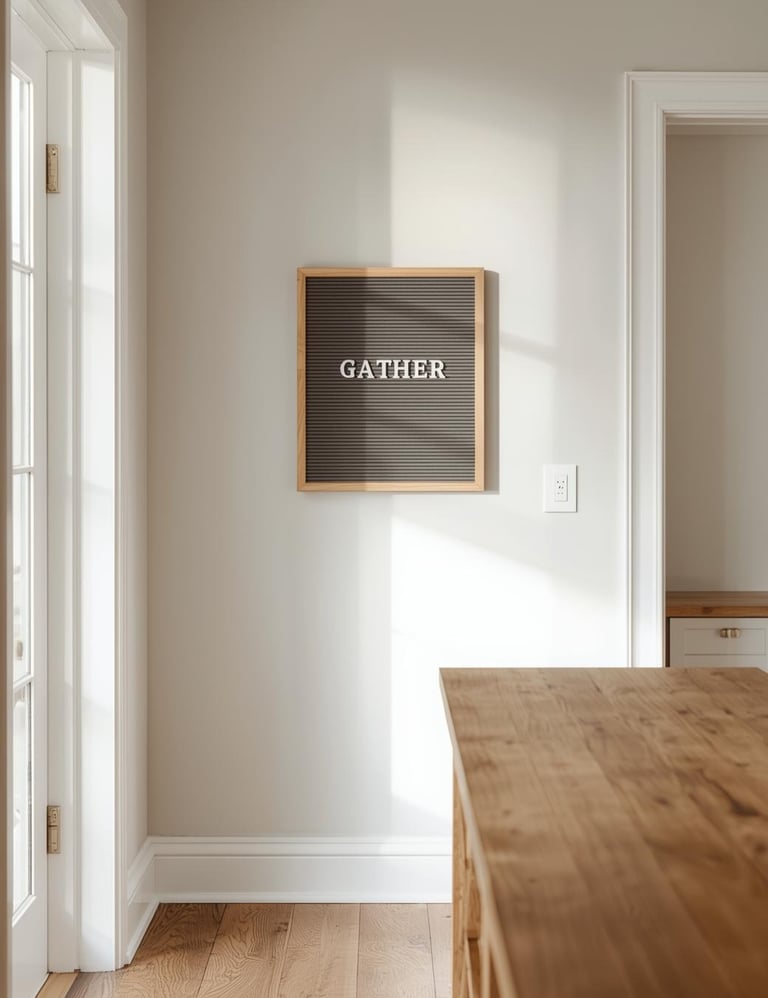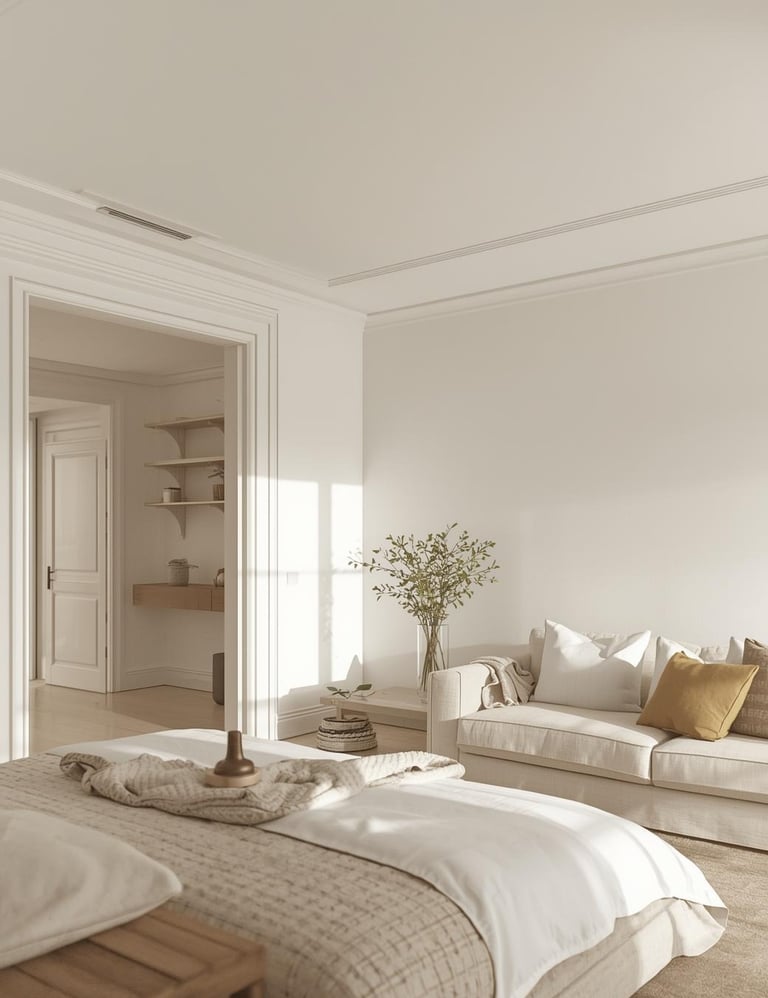20 Minimalist Wall Decor Ideas for a Clean, Serene Space
HOME DECOR
Allison W.
10/20/2025
You know that feeling when you're staring at your blank walls, scrolling through endless gallery wall inspiration, and instead of feeling excited, you just feel... overwhelmed? I was there not too long ago. Everyone seemed to be filling every inch of wall space with photos, prints, and collections, and while those maximalist walls looked gorgeous, something about them didn't feel quite right for me.
That's when I discovered the beauty of minimalist wall decor—and honestly, it changed everything. I realized that my walls didn't need to be packed with stuff to be beautiful. Sometimes, one perfect piece creates more impact than twenty scattered ones. Sometimes, the breathing room itself is the design.
Here's what I love most about minimalist wall decor: it's not about being cold or boring or following some strict rules. It's about being intentional. It's choosing pieces that truly matter to you and letting them shine without competition. It's creating calm, serene spaces that feel like a deep breath after a hectic day.
Whether you're naturally drawn to simplicity or you're just tired of visual clutter, these 20 minimalist wall decor ideas will show you how less truly can be more. From single statement pieces to the beauty of bare walls, you'll find approachable ideas that create impact without overwhelm. Ready to simplify and beautify your walls? Let's dive in!
1. Single Large-Scale Art Piece
Sometimes, one oversized piece of artwork is all you need to make a wall absolutely stunning. There's something so powerful and intentional about a single large-scale art piece that commands attention without needing any supporting cast. It's minimalism at its finest—maximum impact with minimal effort.
I hung a large abstract canvas above my sofa a few months ago, and it completely transformed the room. Instead of fussing with multiple frames and trying to get a gallery wall "just right," I had one beautiful focal point that made the entire space feel more pulled together and sophisticated. Plus, it was so much easier than I thought it would be!
The key to making this work is choosing something that genuinely speaks to you. Don't just grab the first oversized print you see—take your time finding a piece that you'll love looking at every single day. Whether it's abstract art in soft neutrals, a bold black and white photograph, a colorful landscape, or even a simple line drawing blown up to large scale, let it be something meaningful.
Here's the beauty of this approach: large-scale art doesn't have to break the bank! You can find affordable oversized prints on Etsy (search for printable art and have it printed at your local print shop), create your own abstract piece with a large canvas and acrylic paints, or even thrift a big frame and fill it with something you love. The investment is in the impact, not necessarily the price tag.
When hanging your piece, give it plenty of breathing room. Don't crowd it with other decor on the same wall—let it stand alone and be the star of the show!
2. Simple Floating Shelves
Floating shelves are the perfect minimalist wall solution because they're both functional and beautiful—but only if you style them with restraint. The secret to minimalist shelf styling is embracing negative space and resisting the urge to fill every inch.
I installed two simple wooden floating shelves in my living room, and instead of loading them up with knickknacks, I kept it sparse: a small stack of my favorite books, one beautiful ceramic vase, and a tiny trailing plant. That's it. The simplicity makes each item feel more intentional and special, and the shelves add interest to my wall without creating visual clutter.
Here's my styling formula for minimalist floating shelves: choose one to three items maximum per shelf, and make sure there's plenty of empty space between them. Think about varying heights—maybe a tall vase next to a short stack of books—but keep everything in a cohesive color palette. Neutrals work beautifully, but you could also do all white objects, all natural wood, or all black for that monochromatic minimal vibe.
What to display? A few beautiful coffee table books you actually read, one small plant (real or faux), a sculptural object like a ceramic bowl or wooden sphere, or a single framed photo. The key is curation—only your absolute favorites earn a spot.
Floating shelves are also super budget-friendly and renter-friendly! You can find affordable options at Amazon, Target, or even make your own with a piece of wood and shelf brackets. Just remember: the minimalism comes from what you don't put on them as much as what you do!
3. Black and White Photography
There's something timelessly elegant about black and white photography on your walls. It's sophisticated, it never goes out of style, and it creates impact without adding color or visual noise to your space. For minimalist wall decor, black and white prints are basically perfect.
I love how versatile black and white photography is—it works with literally any color scheme and any design style. Whether your home is modern, traditional, bohemian, or somewhere in between, black and white prints just fit. They add visual interest and personality without competing with your other decor.
For a truly minimalist approach, choose one large black and white photograph in a simple frame, or create a small grid of matching frames with coordinating black and white images. The key is keeping it cohesive—same frame style, same mat size, similar subject matter or aesthetic. Maybe it's four architectural photos in a perfect square arrangement, or three landscape images in a horizontal row.
Where to find black and white photography? You could print your own photos (honestly, some of my favorite wall art is from trips I've taken!), download affordable printables from Etsy, support photographers on platforms like Unsplash or Society6, or even find vintage photography at thrift stores and antique shops.
Keep the framing simple too—black frames for a modern look, natural wood for warmth, or white frames for that bright Scandinavian vibe. Add a white mat around each print to give it breathing room and that gallery-quality feel. The restraint in color makes these pieces feel sophisticated and intentional—exactly what minimalist decor is all about!
4. Elegant Line Art
Line art prints are having such a moment right now, and they're absolutely perfect for minimalist wall decor! These simple, continuous line drawings—whether they're faces, figures, plants, or abstract shapes—create visual interest with the most minimal means possible. It's literally just lines, and yet they're so captivating and modern.
What I love about line art is how it adds personality and artistry to your walls without any visual heaviness. There's no color to coordinate, no busy patterns to balance—just clean, elegant lines that feel both sophisticated and approachable. A single line drawing of a woman's profile or an abstract face can become a stunning focal point that elevates your entire space.
You can go super minimal with just one line art print in a simple black or natural wood frame, or create a small, curated collection of two or three complementary pieces. I have two line drawings in my bedroom—one is an abstract female figure, and the other is a simple botanical stem—and they're both in matching thin black frames. The simplicity is what makes them work so beautifully together.
Finding line art is easy and budget-friendly! Etsy is packed with downloadable line art prints that you can purchase for just a few dollars and print at home or at your local print shop. You can also find original pieces from artists on Instagram or at local art markets. And if you're feeling creative, try drawing your own! Line art is actually one of the most accessible forms of art to create yourself.
Frame your line art simply and give it plenty of wall space to breathe. These pieces are meant to be appreciated for their elegant simplicity, so don't crowd them with other competing elements. Let those beautiful lines do the talking!
5. Neutral Abstract Art
If you want to add texture and visual interest to your walls without introducing color or pattern overload, neutral abstract art is your answer. Think soft beiges, warm grays, creamy whites, and gentle taupes all blended together in abstract compositions that feel calming and sophisticated.
I recently swapped out a colorful print in my living room for a large neutral abstract piece, and the difference in how the room feels is incredible. Instead of the art demanding attention, it gently complements everything else in the space. It adds that artistic touch without creating visual noise, which is exactly what I was craving.
Neutral abstract art works beautifully in minimalist spaces because it adds dimension and interest through texture and subtle tonal variations rather than bold colors or patterns. It's sophisticated without being showy, interesting without being overwhelming. These pieces often have this organic, flowing quality that makes spaces feel more peaceful and grounded.
You can find affordable neutral abstract prints on Etsy, Society6, or Amazon. Or—and this is one of my favorite budget options—create your own! Grab a canvas and some acrylic paints in various neutral tones, and just play. Abstract art is so forgiving because there's no "right" way to do it. Layer your neutrals, create texture with a palette knife, add some organic shapes, and suddenly you have original art that's perfectly suited to your space.
Try pairing two complementary neutral abstract pieces side by side for added impact, or let one large piece stand alone. Either way, the soft, muted palette keeps everything feeling calm and minimalist while still adding that essential touch of artistry to your walls.
6. Single Statement Mirror
A beautiful mirror isn't just functional—it's one of the most impactful pieces of minimalist wall decor you can add to your space. One well-chosen mirror can serve as your entire wall decor strategy, reflecting light, making your room feel larger, and adding a sculptural element that's both practical and gorgeous.
I hung a large round mirror with a thin brass frame above my console table, and it's become the focal point of my entryway. It didn't need anything else around it—no flanking sconces, no additional art, nothing. The mirror itself is the statement, and the simplicity of having just that one piece makes the space feel so much more intentional and calm.
When choosing a mirror for minimalist wall decor, think about shape and frame style. Round mirrors feel soft and organic, arched mirrors add architectural interest, and simple rectangular mirrors with minimal frames are classic and versatile. The frame should be understated—thin metal, natural wood, or even frameless for that ultra-minimal look.
Mirrors are also strategic decorating tools! They bounce natural light around your room, making spaces feel brighter and more open. Position your mirror across from a window to maximize this effect, or place it where it will reflect something beautiful like a plant or piece of art from another wall.
You can find beautiful statement mirrors at HomeGoods, West Elm, Amazon, or even thrift stores (vintage mirrors often have the most character!). Hang it as your solo wall decor and trust that sometimes, one perfect reflective piece really is all you need. The mirror adds dimension and light without any of the visual weight that traditional art might bring!
7. Architectural Prints
There's something so sophisticated and clean about architectural prints on your walls. Whether it's a photograph of a beautiful building, a vintage blueprint, or a simple line drawing of architectural details, these pieces add visual interest with a refined, minimalist aesthetic that feels both artistic and intellectual.
Architectural prints work beautifully in minimalist spaces because they tend to have clean lines, geometric elements, and often a monochromatic or neutral color palette. They're interesting without being busy, sophisticated without being pretentious. I have a simple black and white photograph of a modernist building in my home office, and it adds just the right amount of visual interest without distracting from my work.
What I love about this type of wall art is how versatile it is. It can lean modern and sleek with photos of contemporary architecture, or feel vintage and nostalgic with old blueprints or historic building sketches. Either way, the structured, geometric nature of architectural imagery creates this sense of order and calm that's perfect for minimalist spaces.
Where to find architectural prints? Etsy has tons of downloadable blueprint prints and architectural photography. You can also find beautiful options on Society6, or even print your own photos if you've traveled to cities with stunning architecture. Thrift stores sometimes have vintage architectural drawings or blueprints that are absolute gems!
Keep the framing simple and let the architectural details shine. A thin black frame works beautifully for a modern look, while natural wood adds warmth. You can hang one large architectural print as a statement piece, or create a small series of three coordinating prints in a row. The key is keeping everything cohesive—same frame style, similar subject matter, and that clean minimalist aesthetic that makes these pieces so timeless and elegant.
8. Simple Wooden Wall Art
Natural wood pieces are such a beautiful way to add warmth and organic texture to minimalist walls without introducing visual clutter. Whether it's a simple wooden circle, an arched wooden shelf, or a carved geometric shape, wooden wall art brings that earthy, grounded element that makes minimalist spaces feel less sterile and more inviting.
I love how wooden wall decor bridges the gap between minimalism and warmth. It's simple and understated, but the natural grain and texture of wood add so much character and coziness. I have a round wooden shelf in my bedroom that holds just one small plant, and it's become one of my favorite pieces—it's functional, beautiful, and adds that natural element that makes the room feel more alive.
The key to wooden wall art in minimalist spaces is keeping it simple. Think clean lines, natural finishes, and unadorned shapes. A circular wooden shelf, a simple wooden arch, a hand-carved geometric piece, or even a beautiful piece of driftwood mounted on the wall. The wood grain itself provides all the visual interest you need—no need for paint, embellishments, or anything extra.
You can find simple wooden wall pieces at stores like West Elm, Amazon, or even IKEA. Etsy is also amazing for handcrafted wooden wall art from small makers. And if you're handy, this is a super approachable DIY project! Grab a circular piece of wood from the craft store, sand it smooth, apply a natural stain or leave it raw, and mount it on your wall. Instant minimalist art with that warm, organic touch that makes all the difference in creating a space that feels both clean and cozy!
9. Monochromatic Gallery Wall
If you love the idea of a gallery wall but want to keep things minimal, a monochromatic approach is your answer. The trick is creating a small, curated collection using only one color family—keeping everything cohesive through color, framing, and restraint.
I created a small monochromatic gallery wall in my hallway using only black and white prints in matching black frames with white mats. Instead of the usual dozen-plus frames you see in traditional gallery walls, I used just four pieces arranged in a perfect grid. The result? All the personality and visual interest of a gallery wall, but with that clean, intentional minimalist vibe I was going for.
Here's what makes a monochromatic gallery wall work: consistency is key. Choose frames in the same color and style—all black, all natural wood, or all white. Use the same mat color and size for each piece. Keep your artwork within one color family, whether that's all black and white, all neutrals, or all sepia tones. This cohesion creates harmony instead of visual chaos.
The layout matters too! For a truly minimalist approach, stick to simple arrangements like a perfect grid (four squares, six rectangles) or a clean linear row. Avoid the asymmetrical, salon-style arrangements that can feel busy. Symmetry is your friend here—it creates order and calm.
And here's the most important rule: less is more. Limit yourself to 3-6 pieces maximum. The restraint is what keeps it minimal. You're creating a curated moment on your wall, not filling every inch of space. Give your gallery wall plenty of breathing room, and let that monochromatic cohesion speak for itself!
10. Textured Wall Hanging
A single woven or macramé wall hanging in neutral tones is the perfect way to add dimension and softness to minimalist walls without creating visual clutter. It's all about that beautiful texture—the way light and shadow play across the woven fibers creates interest without needing color or pattern.
I have a simple cream-colored macramé hanging above my bed, and it adds so much warmth and organic texture to the space. What I love most is how it softens the room without competing with anything else. It's just there, quietly beautiful, adding that tactile element that makes minimalist spaces feel more inviting and less stark.
The key to keeping wall hangings minimal is choosing pieces with simple, clean designs. Avoid overly busy patterns or chunky, elaborate knots. Look for streamlined woven pieces with gentle fringe, simple macramé with clean lines, or woven wall baskets in natural fibers. The texture itself provides all the visual interest you need—the design should be understated.
Stick with neutral colors like cream, white, beige, natural jute, or soft gray. These tones keep everything feeling calm and cohesive while the texture adds that cozy, organic touch. Natural fibers like cotton, jute, wool, or linen work beautifully and reinforce that minimalist-meets-natural aesthetic.
You can find beautiful textured wall hangings on Etsy from artisan makers, at stores like Urban Outfitters or Anthropologie, or even try making your own if you're crafty! Hang your piece solo on the wall with plenty of space around it—let the texture be the star without crowding it with other decor!
11. Single Botanical Print
One beautiful plant or leaf print in muted tones is such an elegant way to bring a touch of nature to your walls without the literal maintenance of actual plants. It's fresh, organic, and timelessly sophisticated—everything minimalist wall decor should be.
I have a simple eucalyptus print in my bathroom, and it adds just the right amount of natural beauty without overwhelming the small space. The soft green-gray tones feel calming and spa-like, and because it's just one print in a simple frame, it doesn't create any visual clutter. It's botanical decor at its most minimal and lovely.
The key to botanical prints in minimalist spaces is choosing pieces with clean, simple compositions. A single leaf or stem on a plain background works beautifully. Avoid busy arrangements with multiple flowers or plants—the simpler, the better. Think one graceful palm frond, a single pressed fern, an elegant monstera leaf, or a minimal line drawing of a botanical element.
Muted tones are your friend here. Soft greens, sage, eucalyptus, warm beige backgrounds, or classic black and white botanical illustrations all work perfectly. The subdued color palette keeps everything feeling calm and cohesive rather than adding visual noise.
Frame your botanical print simply with a generous white mat to give it breathing room. Black frames offer a modern look, natural wood adds warmth, or white frames create that fresh, airy Scandinavian vibe. Hang it solo on your wall—no need to pair it with anything else. Let that single botanical moment be enough, bringing just a whisper of nature indoors in the most minimal, beautiful way possible!
12. Empty Frame as Art
Here's a fun, unexpected minimalist approach: use an ornate or interesting empty frame as the art itself. The negative space becomes the focal point, and the frame's design is what creates visual interest. It's quirky, artistic, and perfectly minimal all at once.
I stumbled upon this idea when I found a gorgeous vintage frame at a thrift store but couldn't find the right art to fill it. On a whim, I hung it empty on my wall, and I honestly love it more than if I'd filled it with a print! The ornate gold detailing stands out beautifully against my white wall, and there's something so intentional and artistic about the emptiness inside.
This approach works best with frames that have interesting details or character. Think vintage ornate frames with beautiful carved details, antique gold or brass frames with patina, architectural frames with unique shapes, or even modern frames with interesting geometric designs. The frame itself needs to be visually interesting enough to stand alone.
You can paint the frame to suit your aesthetic—white for a fresh, modern look, matte black for drama, or leave it in its original finish if it's already beautiful. Hang it where wall color or texture can show through the empty center. A textured wall, a boldly painted accent wall, or even a beautifully painted standard wall all work as the "art" inside your empty frame.
This is such a budget-friendly option too! Hit up thrift stores, estate sales, or your grandma's attic for interesting vintage frames. One frame, no art needed, instant minimalist statement. It's conversation-starting, totally unique, and proves that sometimes the best art is the space itself!
13. Simple Clock as Decor
A minimalist wall clock isn't just functional—it can be a beautiful piece of decor that stands alone as your entire wall art strategy. The right clock becomes both a practical necessity and a sculptural statement that adds interest without any visual clutter.
I have a large, simple clock with a white face and thin black hands in my kitchen, and it's honestly one of my favorite design elements in the room. It's clean, it's useful, and it fills the wall space in such an effortless way. No need to fuss with gallery walls or worry about finding the perfect art—the clock does all the work while actually serving a purpose!
The key to using a clock as minimalist decor is choosing one with clean lines and simple design. Look for clocks with uncluttered faces, minimal or no numbers, simple hands, and neutral colors. Modern metal clocks with sleek lines, natural wood clocks with Scandinavian vibes, or classic white clocks with black details all work beautifully in minimalist spaces.
Size matters here too! A larger clock makes more of a statement and can hold its own as solo wall decor. Small clocks get lost on big walls, but an oversized clock (think 20+ inches) becomes a true focal point that's both beautiful and functional.
Where to find minimalist clocks? IKEA has great affordable options, West Elm and CB2 offer beautiful modern designs, and Amazon has tons of choices at every price point. Look for keywords like "minimalist," "modern," "Scandinavian," or "simple" when searching.
Hang your clock where it's both visible and useful—kitchen, living room, home office, or bedroom. Let it be the only thing on that wall, and appreciate how something so practical can be so beautifully minimal!
14. Lean Art on Shelf or Mantel
Instead of committing to hanging art on your walls, try the effortlessly casual approach of leaning artwork on a shelf, mantel, or even directly on the floor against the wall. It's minimal, easily changeable, and has this relaxed, "I didn't try too hard" vibe that's so appealing.
I love leaning art because it feels less permanent and more flexible than traditional hanging. I have a large framed print leaning on my fireplace mantel, and I can swap it out whenever I want without putting new holes in my wall. It's perfect for renters or anyone who likes to change things up seasonally without the commitment of nails and picture hooks.
The key to making leaned art look intentional (not just like you forgot to hang it) is keeping it simple and minimal. Lean one or two pieces maximum—not a whole collection. Choose larger pieces that have enough presence to stand on their own. Smaller frames can look unfinished when leaning, but a substantial piece looks purposeful and chic.
Where to lean? Fireplace mantels are the obvious choice and look so elegant with one beautiful piece of art casually propped up. Console tables work beautifully too—lean a large frame behind a simple lamp or small plant. You can even lean oversized art directly on the floor against the wall for that gallery-inspired look, especially effective in bedrooms or along hallways.
Keep the styling around your leaned art minimal. Maybe one small object in front, but don't crowd it. The whole point is that effortless, breathing-room aesthetic. And here's a pro tip: lean your art at a slight angle rather than perfectly straight against the wall—it looks more natural and intentional that way!
15. Single Sculptural Piece
Three-dimensional wall art adds instant interest through dimension and shadow play rather than color or pattern—making it perfect for minimalist spaces. A single sculptural piece in a simple, clean design can be all you need to create a stunning focal point.
I have a modern metal circle sculpture on my dining room wall, and I love how the light creates different shadows throughout the day. It's dynamic and interesting without being busy or colorful. The sculptural element adds depth that flat art can't achieve, making the wall feel more alive and dimensional.
The key is choosing sculptural pieces with clean, simple forms. Think modern metal circles or abstract shapes, minimalist wooden geometric designs, ceramic wall planters with sleek lines, or abstract three-dimensional art in neutral tones. Avoid overly ornate or busy sculptures—the beauty should come from the form and how light interacts with it, not from elaborate details.
Materials matter for minimalist sculptural art. Metal in matte black, brass, or brushed gold feels modern and sophisticated. Natural wood adds warmth and organic texture. White or neutral ceramic keeps everything feeling clean and calm. The material itself becomes part of the artistry.
You can find beautiful sculptural wall art at West Elm, CB2, or Etsy (where independent artists create stunning modern pieces). Even places like Target and HomeGoods sometimes have great minimalist sculptural options at affordable prices.
Hang your sculptural piece solo on the wall with plenty of space around it. The whole point is appreciating the form, the shadows it creates, and the dimension it adds. Let it breathe, let the light play across it throughout the day, and enjoy how something so simple can be so captivating!
16. Whitespace with One Small Accent
Here's the ultimate minimalist move: embrace mostly bare walls with just one tiny, meaningful piece. Sometimes less truly is more, and a mostly empty wall with one small accent creates this sense of calm and intentionality that's so refreshing.
I have a small wall in my hallway that I kept completely bare except for one tiny framed quote that means something special to me. It's maybe 5x7 inches, and it's the only thing on that entire wall. Instead of feeling empty or unfinished, it feels peaceful and intentional. That little piece gets all the attention, and the whitespace around it lets me breathe.
This approach works beautifully for spaces that don't need much—small walls, narrow hallways, powder rooms, or areas between windows or doors. Not every wall needs to make a statement, and sometimes the most powerful statement is restraint itself.
What works as a small accent? A tiny framed quote or saying that's meaningful to you, a mini floating shelf with one small object, a small round mirror, a petite piece of art, or even a single wall hook with something beautiful hanging from it. The key is keeping it small and singular—this isn't the place for a collection or grouping.
The philosophy behind this idea is that minimalism isn't about filling space—it's about being intentional with what you choose to display. If a small accent is all a wall needs, that's perfect. If a wall feels better completely bare, that's perfect too. Give yourself permission to leave walls mostly empty and trust that the breathing room itself is beautiful. Your home doesn't need to be filled to be complete!
17. Peg Rail or Hook Board
A minimalist peg rail or simple hook board is both functional and beautiful—the perfect wall solution for spaces that need to be practical without sacrificing style. It's wall decor that works, and when styled with restraint, it's absolutely gorgeous.
I installed a simple wooden peg rail in my entryway, and it's become one of my favorite features. I keep just three things hanging on it—my everyday jacket, a canvas tote, and a small wreath that changes seasonally. The simplicity makes it feel intentional and calm rather than cluttered, and it's so much prettier than a coat rack or hooks scattered randomly on the wall.
The key to keeping peg rails minimal is restraint in both the design and what you hang. Choose rails with clean lines—Shaker-style wooden pegs, simple modern metal hooks, or a streamlined wood rail with minimal hardware. Avoid overly ornate or busy designs. The rail itself should be simple and understated.
Then, and this is crucial, hang only a few items. Three to five maximum, and make sure they're things you actually use and that look nice hanging. A beautiful coat, a woven basket bag, a simple hat, a seasonal wreath, or a linen apron. Avoid overloading it with random stuff—that defeats the whole minimalist purpose!
Peg rails work beautifully in entryways, mudrooms, bedrooms (perfect for hanging tomorrow's outfit or a robe), kitchens (for aprons and dish towels), or even bathrooms (for robes and towels). They're functional art that adds character to your walls while serving a real purpose. You can find beautiful options at IKEA, Amazon, or even make your own with a board and simple wooden pegs!
18. Subtle Wallpaper Accent
Wallpaper might not seem minimal at first, but when you choose very subtle, barely-there patterns and use them sparingly, it can create the most beautiful textural interest without visual clutter. The key is subtlety and restraint—think soft textures and tonal designs rather than bold patterns.
I added peel-and-stick wallpaper to one small wall section in my bedroom—just the wall behind my headboard—and chose a subtle grasscloth texture in a soft cream color. It adds this beautiful depth and interest without feeling busy or overwhelming. From across the room, it almost reads as a textured paint, but up close, you can see the delicate pattern that makes it special.
For minimalist spaces, look for wallpapers with very subtle patterns: soft linen textures, delicate grasscloth weaves, barely-there geometric patterns in tonal colors, subtle stripes in similar shades, or even textured solid colors that add dimension without pattern. The design should whisper, not shout.
Application is important too. You don't need to wallpaper an entire room—that can feel overwhelming. Instead, do one accent wall, a small section behind shelving, the wall behind your bed, or even just the inside of a bookshelf or closet. Small doses of subtle wallpaper create impact without commitment.
Peel-and-stick wallpaper is perfect for renters or anyone who likes flexibility. It's easy to apply, easy to remove, and lets you experiment without permanent commitment. Brands like Tempaper, RoomMates, and Amazon offer gorgeous subtle options that work beautifully in minimalist spaces.
The beauty of subtle wallpaper is how it adds personality and texture while still maintaining that clean, calm aesthetic. It's a way to make your walls interesting without making them busy!
19. Simple Letter Board or Sign
One minimal sign with meaningful words can be all the wall decor you need. Whether it's a wooden sign, a letter board with a short phrase, or simple metal word art, the key is keeping it concise and impactful—not paragraphs of text, just a few powerful words.
I have a small wooden sign in my kitchen that simply says "gather," and it's perfect. It's meaningful without being preachy, decorative without being cluttered, and it takes up just one small spot on my wall. The simplicity is what makes it work—it's not competing with elaborate fonts or lengthy quotes that feel like too much.
For minimalist spaces, choose signs with clean, simple fonts and short messages. One word ("home," "breathe," "hello"), a brief phrase ("welcome home," "but first, coffee"), or a meaningful short quote that truly speaks to you. Avoid busy, overly decorative fonts or those long paragraphs of text that can feel overwhelming on the wall.
Material and style matter too. A simple wooden sign with black lettering feels rustic and warm. A sleek letter board with black background and white letters feels modern and changeable (which is fun—you can update the message whenever you want!). Metal word art in matte black or brass can be sophisticated and dimensional.
Keep your sign solo on the wall—don't group it with other items. The whole point is letting those few words have impact through simplicity and space around them. Position it where it makes sense contextually: "gather" in the dining room, "relax" in the bedroom, "welcome" in the entryway.
You can find beautiful minimal signs on Etsy, Amazon, or even make your own with wood and vinyl lettering! The key is restraint—fewer words, simple design, and plenty of breathing room around it.
20. Nothing at All
Here's the most minimalist option of all: embrace the beauty of completely bare walls. Sometimes, the most powerful design choice is choosing to leave a wall empty. Not every wall needs something, and there's real freedom and peace in that simplicity.
I have a wall in my living room that's completely bare—no art, no shelves, no decor at all. And you know what? I love it. It gives my eyes a place to rest, it makes the room feel more spacious and calm, and it lets the other elements in the room (like my furniture and the few pieces of art I do have) really shine without competition.
Bare walls work beautifully when you have interesting wall texture or color, architectural details like beautiful molding or exposed brick, or when you simply want to create breathing room in your space. Sometimes a wall is lovely just as it is, and adding something would actually detract rather than enhance.
The philosophy here is that minimalism isn't about filling every space—it's about being intentional. If a wall feels right bare, then leave it bare! You're not obligated to decorate every surface. In fact, bare walls can make your home feel more peaceful, more spacious, and more intentional than walls packed with stuff.
This is especially powerful in bedrooms where calm is key, in small spaces that benefit from visual breathing room, or in rooms where you already have plenty of visual interest from furniture, windows, or other architectural elements.
Give yourself permission to leave walls empty. Trust that sometimes, the most beautiful thing you can put on a wall is absolutely nothing at all. Embrace the whitespace, enjoy the simplicity, and let your walls breathe. Your home will thank you for it!
And there you have it, friend—20 minimalist wall decor ideas that prove less truly can be more. Each idea shows you how to create beautiful, intentional walls without filling every inch of space or overwhelming your senses with visual clutter.
Here's what I hope you take away from this: minimalist wall decor isn't about deprivation or following strict rules. It's about choosing pieces that genuinely matter to you and giving them the space to shine. It's about creating calm, breathing room in your home where you can actually relax and think clearly. It's about being intentional rather than just filling space because you feel like you should.
Maybe you're drawn to that single large-scale art piece, or perhaps the idea of completely bare walls feels like exactly what you need right now. Whatever resonates with you, trust that instinct! Your walls are yours to design—or not design—however feels right.
Start with just one wall if you're feeling overwhelmed. Try one idea that speaks to you and see how the simplicity feels. You might be surprised at how peaceful and beautiful your space becomes when you embrace restraint and let your walls breathe.
Remember, minimalism isn't about having nothing—it's about having exactly what you need and love, and nothing more. So go ahead and simplify those walls with confidence. Here's to creating calm, beautiful spaces that let you breathe! Happy decorating!
*This page contains affiliate links. If you buy through them, I may earn a commission at no extra cost to you.

